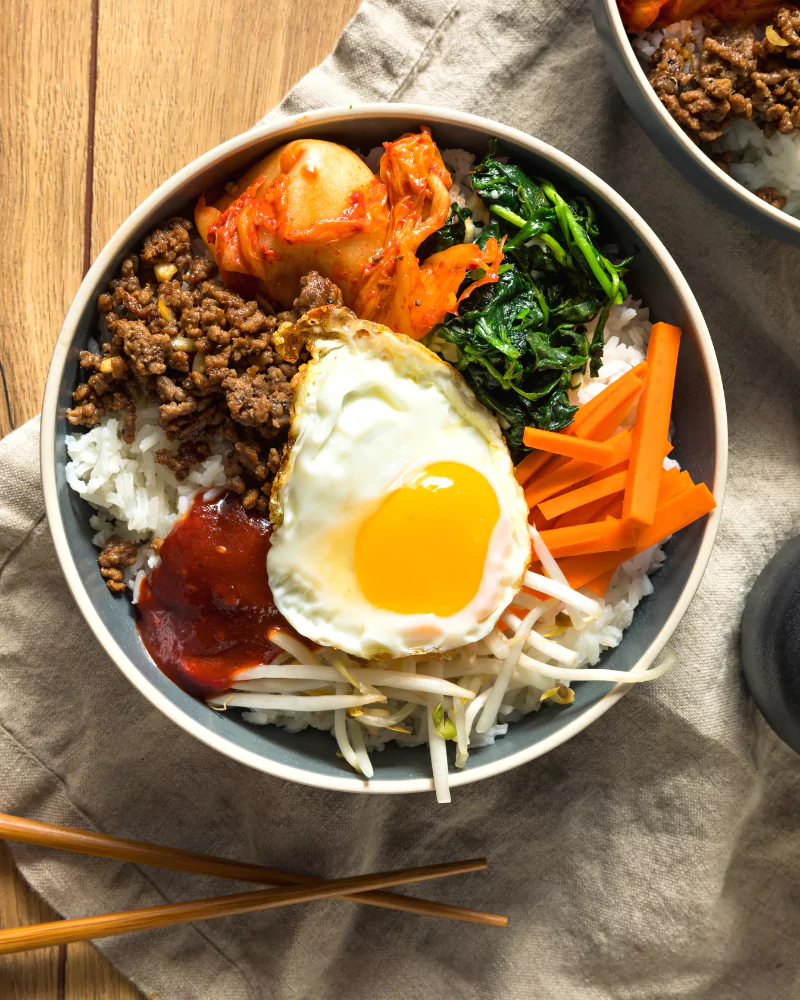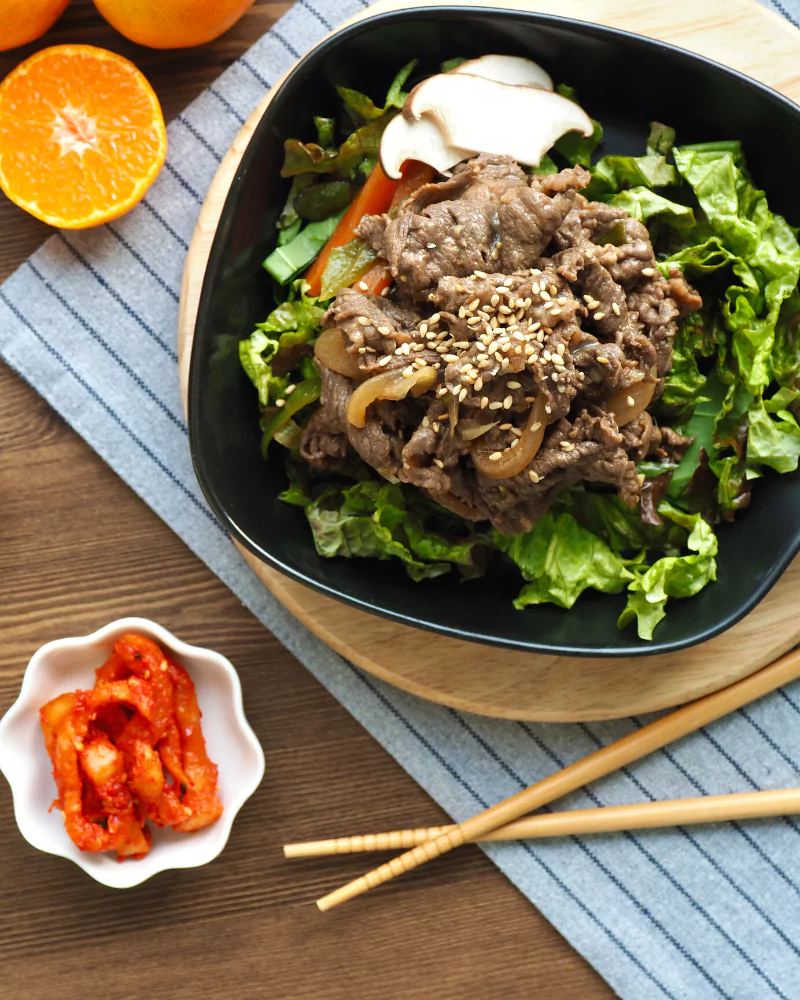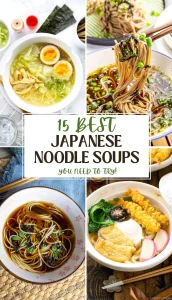Have you ever wondered about the tasty world of Korean food? Well, I’m here to tell you about two super-popular dishes, bibimbap vs bulgogi, and answer the burning question: What’s the difference between them? They might sound a bit similar, but trust me, they’re like flavor cousins with their unique styles.
So, let’s take a simple stroll into bibimbap and bulgogi to figure out what makes them so special and what sets them apart in the yummy land of Korean eats!

What is Bibimbap?
Bibimbap is a tasty Korean dish that’s all about mixing things up. The name “bibimbap” (pronounced bee-bim-bap) means “mixed rice.” Here’s how it works: you start with a bowl of rice, and on top, you put all sorts of colorful veggies like spinach, carrots, bean sprouts, mushrooms, and sliced cucumber. There’s also some kind of meat, usually beef, and a fried or sunny-side-up egg.
What makes bibimbap special is the spicy sauce called gochujang. It’s a red chili paste that adds a lot of flavor. Before you eat it, you mix everything well. The mix of different textures and tastes makes bibimbap a delicious and satisfying dish loved by people in Korea and all over the world.
Bibimbap Popular variations:
Bibimbap has several popular variations that add unique twists to its classic recipe. Here are a few noteworthy versions:
- Dolsot Bibimbap: In this variation, bibimbap is served in a hot stone pot called a “dolsot.” The stone pot is preheated, resulting in a deliciously crispy layer of rice at the bottom.
- Yukhoe Bibimbap: This version features raw beef, often seasoned with soy sauce, sesame oil, and other flavorings. The heat from the rice and mix-ins partially cooks the beef, creating a delightful blend of textures.
- Hwe Bibimbap: Hailing from the coastal regions of Korea, Hwe Bibimbap focuses on fresh, raw seafood as the protein component, providing a lighter and refreshing twist to the dish.
- Bibimbap with Namul (Seasoned Vegetables): Some variations emphasize specific seasoned vegetables, adding more depth to the dish. Namul, which refers to seasoned and sautéed vegetables, can include a variety of greens like bracken fern, bellflower root, or watercress.
- Jeonju Bibimbap: Originating from the city of Jeonju, known for its food culture, this version often includes a more extensive array of ingredients and a slightly sweeter gochujang sauce.
- Bibim Noodles (Bibim Guksu): Instead of rice, this variation uses thin, chewy noodles as the base, offering a different texture and flavor experience.
- Sheet Pan Bibimbap: it’s a clever and easy version of the classic Korean dish Bibimbap. You toss all the yummy stuff like oyster mushrooms and sweet potatoes on one tray, making it a breeze to cook.
These variations showcase the versatility of bibimbap, allowing it to adapt to regional preferences and creative interpretations while retaining its essence as a delightful mixed-rice dish.

What is Bulgogi?
Bulgogi is a tasty Korean dish with meat, usually beef. Its name, “bulgogi,” means “fire meat” in Korean (불고기). Here’s how it works: we take thin slices of beef and soak them in a mix of soy sauce, sugar, sesame oil, garlic, and pepper. Then, we cook the marinated meat on a grill or in a pan until it’s tender and a bit caramelized.
People often eat bulgogi with rice and sometimes wrap it in lettuce leaves with veggies. It’s a yummy and popular dish not just in Korea, but all around the world.
Bulgogi Popular variations:
Also, Bulgogi has some cool versions Here are a few noteworthy versions:
- Chicken Bulgogi (Dak Bulgogi): Instead of beef, this one uses chicken. It’s soaked in tasty sauce and then cooked up on a grill or in a pan.
- Pork Bulgogi (Daeji Bulgogi): If you’re a fan of pork, this version has thinly sliced pork soaked in a sweet and savory sauce – a different but delicious twist.
- Bulgogi Hot Pot (Jeongol): This is where we cook bulgogi with lots of veggies and noodles in a hot pot. Perfect for a cozy meal, especially when it’s chilly outside.
- Bulgogi Taco: Imagine putting bulgogi in a taco – a mix of Korean and Mexican flavors all in one bite.
- Spicy Bulgogi (Gochujang Bulgogi): This one adds a bit of heat by using gochujang, a red chili paste, in the marinade. It gives bulgogi a spicy kick.
These versions show how bulgogi can be super flexible, changing a bit to suit different tastes while still keeping its tasty grilled goodness.
Bibimbap vs. Bulgogi: A Food Showdown
Flavor:
- Bibimbap: Lots of different flavors mix together – veggies, tasty meat, and a bit of spice from gochujang. You get a bit of crunch and a lot of yum!
- Bulgogi: It’s sweet and savory – the meat is kind of sweet and has a yummy grilled taste. It’s like a party in your mouth!
Ingredients:
- Bibimbap: Colorful veggies like spinach, carrots, and more, plus beef and a fried egg, all on a bed of rice. Don’t forget the spicy gochujang sauce on top!
- Bulgogi: Thin slices of meat (usually beef) soaked in a mix of tasty stuff like soy sauce, sugar, and garlic. Then, it’s grilled or stir-fried to perfection.
Cooking:
- Bibimbap: Each ingredient is cooked separately, and then everything is put together on top of rice. You mix it up just before eating.
- Bulgogi: The meat gets a flavor bath before hitting the grill or pan. It comes out tender and full of flavor, with a slightly crispy outside.
Regions:
- Bibimbap: People all over Korea love it, and each region has its own spin on it. Jeonju is especially famous for its slightly sweet bibimbap.
- Bulgogi: It’s everywhere in Korea, with different styles in different places. Jeolla Province, including Jeonju, does a special kind with extra tasty ingredients.
So, whether you like the mixed-up goodness of bibimbap or the sweet and savory grill party of bulgogi, Korean food has something tasty for everyone!
Choosing Between Bibimbap and Bulgogi
Personal Preferences: Consider what flavors and textures you enjoy. If you like a mix of veggies, meat, and a bit of spice, bibimbap might be your go-to. If you prefer the sweet and savory goodness of grilled meat, then bulgogi could be your top pick.
Occasions and Settings: Think about where and when you’re eating. Bibimbap’s colorful presentation makes it great for casual meals or when you want a variety of tastes in one bowl. Bulgogi, with its grilled charm, is perfect for gatherings where you want to savor that tasty, marinated meat.
Cultural Significance: Consider the cultural context. Bibimbap and bulgogi are both iconic Korean dishes, but they represent different aspects of Korean cuisine. Bibimbap showcases the art of combining diverse flavors, while bulgogi highlights the mastery of marinating and grilling meat.
Health Considerations: For a balanced meal with a mix of veggies and protein, bibimbap is a good choice. It offers a variety of nutrients. On the other hand, if you’re watching your meat intake or prefer leaner options, bulgogi provides a delicious, marinated alternative.
When choosing between bibimbap and bulgogi, it ultimately comes down to your taste preferences, the occasion, cultural appreciation, and your health considerations. Both dishes bring unique elements to the table, making Korean cuisine a delightful journey of flavors and choices.
Conclusion
Choosing between Bibimbap and Bulgogi is like picking your favorite color in a crayon box. Bibimbap is a mix of colorful veggies and tasty stuff, like a flavor party in a bowl. Bulgogi is all about sweet and savory grilled meat, like a delicious barbecue. It just depends on what you like – lots of colors and textures or the tasty grilled goodness. Either way, both dishes show off the yummy side of Korean cooking!
FAQ
What’s the main difference between Bibimbap and Bulgogi?
The main difference lies in their preparation and focus. Bibimbap is a mixed rice dish with colorful veggies, meat, and a spicy sauce, while Bulgogi is marinated and grilled or stir-fried meat, typically beef.
Can I find vegetarian versions of Bibimbap?
Absolutely! You can enjoy a vegetarian Bibimbap by skipping the meat and focusing on a variety of seasoned and sautéed vegetables. It’s a delicious and satisfying option for vegetarians.
Is Bulgogi always made with beef?
While beef is the most common meat used in Bulgogi, variations exist. Pork Bulgogi (Daeji Bulgogi) and Chicken Bulgogi (Dak Bulgogi) are popular alternatives, offering different flavors and textures.
Are there specific regional styles of Bibimbap and Bulgogi in Korea?
Yes, indeed. Different regions in Korea have their own take on these dishes. For example, Jeonju is famous for its slightly sweeter Bibimbap, while Jeolla Province is known for a unique style of Bulgogi, often incorporating additional ingredients for added richness.




